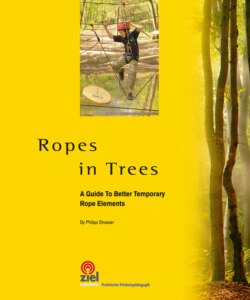Читать книгу Ropes in Trees - Philipp Strasser - Страница 7
На сайте Литреса книга снята с продажи.
ОглавлениеIntroduction
Nature has long been a place to find rest and adventure. At first it was approached in its pristine, original shape, accessible and enjoyed only by natural routes and means. Then, in the 20th century, the natural environment was adapted by mankind to make it more readily useful to the greater public and an expanding recreational economy. Ski lifts and slopes are obvious examples of these manmade intrusions.
More recently, the natural environment has been adapted for summer recreational activities. Summer toboggan runs and aerial adventure courses are booming. Today, there are daily discussions about using concrete in the woods or if drilling trees is really necessary.
It is time we ask ourselves: “Is it ethically acceptable to endlessly modify the natural world for recreational purposes? Is there a way to continue to have fun adventures in nature without destroying that world in the process?”
The use of temporary rope elements allows us to have fun and adventure in nature and yet leave nature in the same condition as we found it. It is, of course, inevitable that the presence of humans alone can disturb woodland animals, compact the ground, and leave small traces on the trees - even if tree protection pads are applied. But by employing temporary rope elements we can significantly reduce mankind’s negative impact on the natural world and work towards the goal expressed by the mountaineer Edmund Hillary: “Take nothing but pictures, leave nothing but footprints.”
Temporary rope elements are not only environmentally advantageous, they are readily adaptable to numerous locations as well. They allow us to create challenging rope courses in a wide variety of different places: trees, rocks, bridges, or houses can be used as well as concrete or steel buildings such as gyms or shopping malls.
Rope elements can be set up close to the ground or be built to elevate participants to dizzying heights. They can be set up in quiet forests and mountains or in buzzing cities. The possibilities are practically limitless.
But temporary rope elements do not only offer infinite location possibilities. A single element can also be altered to offer numerous variations for all kinds of participants. Small children or seniors, wheelchair users or people with special needs, accomplished climbers or sedentary office workers, individuals or large groups. Temporary rope elements offer a wide variety of options.
Temporary rope elements also offer rich rewards for teambuilding, interpersonal communication, anger management, social interaction and interpersonal growth. Courses can be designed to simply provide a fun easy climb, or provide the rigorous challenge and exhilaration of exercising at great heights. The beauty of temporary rope courses is that they are endlessly adaptable to the environment at hand and the goals of the builder.
Equipment such as ropes, locking carabiners, rappelling devices or pulleys originate mostly from mountaineering, but we must not forget frequently used equipment that is used in industrial climbing or urban forestry. Conventional climbing equipment often limit us as we get close to the ground, especially if heavy duty round slings are necessary.
Logs and other similar wood can be integrated in elements, as well as car tires, balloons, tarpaulins and fabrics, etc. – as long as all safety requirements are met, there are no limits for creativity.
This book introduces numerous new elements, while the more familiar elements were reworked and updated with advanced safety requirements in mind. The focus of this book is on designing, building, and installing these elements.
In the second edition, some tips and tricks were improved and some figures slightly modified. From reader’s suggestions, there is a chapter that deals with the different uses of steel maillon rapides and locking carabiners for temporary rope elements.
At first, low elements without belays are discussed. With the various techniques introduced, it is possible to build several low elements without leaving the safety of the ground. This can be beneficial for those who are not legally allowed to work at heights.
Second, high elements that are easily built and installed are described. For example, crate climbing only requires a top rope belay. Complex elements are also discussed such as the High Drawbridge or the Caving Ladder, which demand higher climbing and building skills. Each element is described and includes tips, techniques and safety instructions.
This book is sequentially ordered. First we explore tips and tricks of how to build an element and secure and use it. Then more elements are discussed where you can apply what you have learned previously.
Knots, ties, or designs that are necessary for setting up temporary rope elements are described in detail with many illustrations. Applications that are already generally familiar and frequently used in other areas, like the figure eight knot or the Munter Hitch, are not described in detail.
We applaud the fact that women are now more involved than ever in the world of outdoor recreation. Until the middle of the last century, there were almost no women working as mountain or ski guides. Today, the numbers are almost equal. However, in the interest of simplicity and readability we may employ single gender terms like “he” (when we are referring to either gender) in order to avoid sentences like: “He/she is responsible to show him/her, the safety procedures.”
This book not only addresses existing elements and new ideas but also introduces a discussion about techniques, safety, designs, and legal guidelines regarding rope elements. It also shows that there is no contradiction between creativity and safety – they can work hand-in-hand.
